Menus
- The rivals: BMW S 1000 RR and Ducati 1199 Panigale S.
- PS data and measured values
- Test tire
- Recording systems in use
- Price comparison for Ducati Panigale 1199 S and BMW S 1000 RR
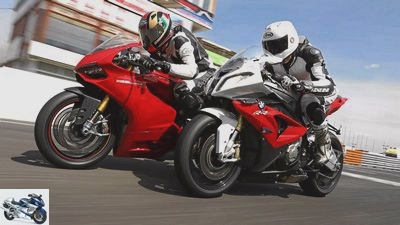
Jahn
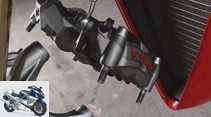
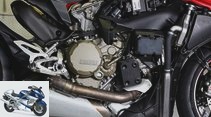
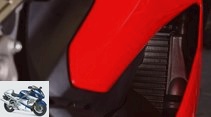
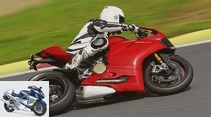
16 photos
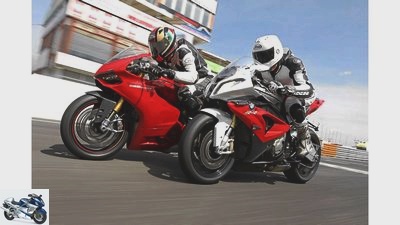
Jahn
1/16
Can the Ducati 1199 Panigale S overthrow the overwhelming BMW S 1000 RR from the throne of superbikes? Does its unconventional, ultra-compact structure beat the conventional but extremely consistently tailored Bavarian? 190 Italo stallions are hotter on the clutch than 197 Bavaria draft horses? Or DTC, EBC, DES, DQS and ABS bring the decisive advantage over ABS and DTC, automatic gearshifts and heated grips?
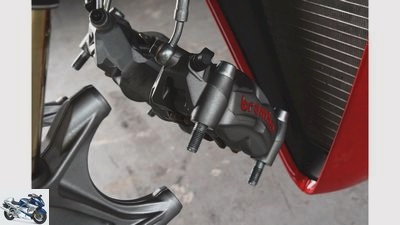
Jahn
2/16
The Ducati brakes are great.
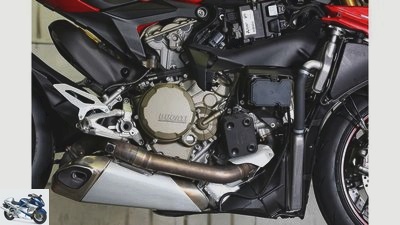
Jahn
3/16
But even without the fairing, the twin remains hidden behind all sorts of control units and the like.
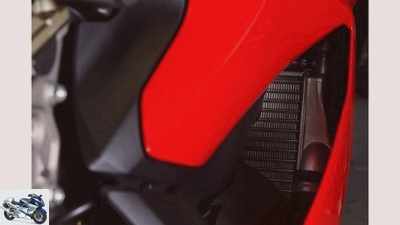
Jahn
4/16
With the Duc, the essentials are hidden behind the fairing.
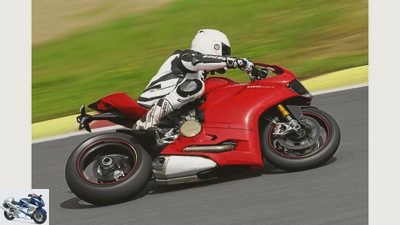
Jahn
5/16
The 1199 Panigale S can initially overwhelm a hobby driver with its light-footed handling, fat power and precision.

Jahn
6/16
The four-cylinder power plant is exemplary anyway.
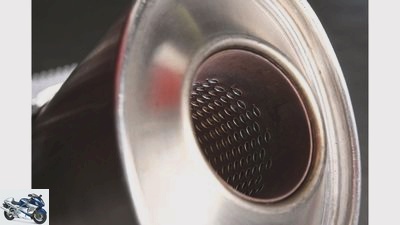
Jahn
7/16
Large-scale production at the highest level.
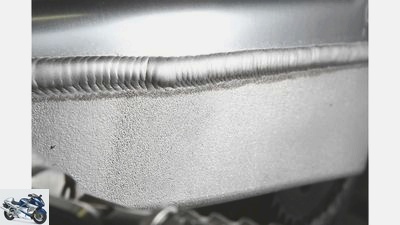
Jahn
8/16
Welds and other details convince with BMW.
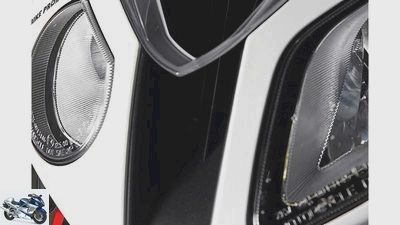
Jahn
9/16
Whether fairing gills, central Ram Air inlet or asymmetrical headlights, the S 1000 RR can carry everything confidently.
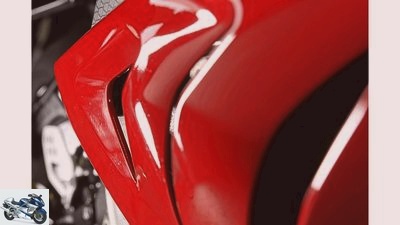
Jahn
10/16
You can argue about design, but you don’t have to.
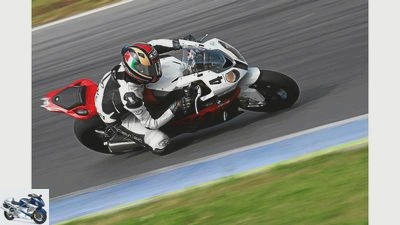
Jahn
11/16
BMW S 1000 RR: A four-in-a-row, encompassed by a solid aluminum bridge frame, yes, that has been known for decades.
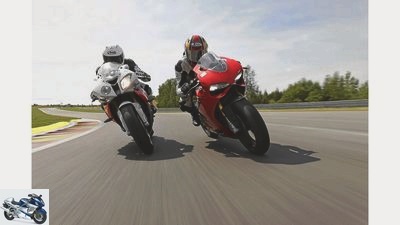
Jahn
12/16
In the first lap, the Ducati is a bit more shy than the conventionally designed BMW.
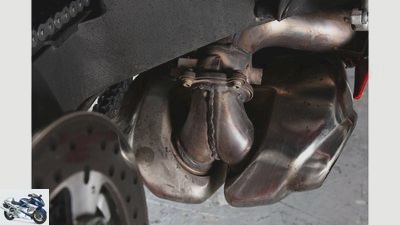
Jahn
13/16
The "Bull soldering" belong to the most minimalist exhaust system in mass production.
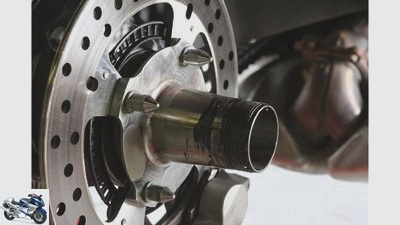
Jahn
14/16
Mechanic’s dream: the Panigale’s single-sided swing arm allows easy rear wheel changes.
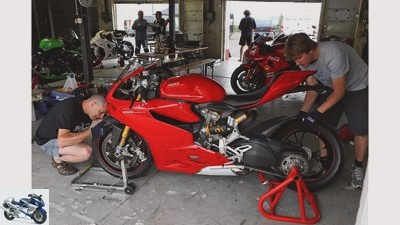
Jahn
15/16
No serious racetrack test can do without uniform test tires. In this case, we used the Pirelli Diablo Supercorsa tread tire in the medium mixture SC2, which is very popular with amateur racers.
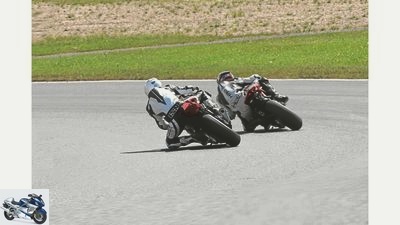
Jahn
16/16
The air is getting tight for the BMW S 1000 RR. During this test, she had to use all her tricks to keep the Ducati 1199 Panigale S at a distance. The Italian proves her strengths in terms of braking and handling.
Comparison test: BMW S 1000 RR against Ducati 1199 Panigale S.
The rivals: BMW S 1000 RR and Ducati 1199 Panigale S.
Content of
A race track, sticky uniform tires and duelists motivated to the point of hair are ready. The battle of the year has to be fought – BMW S 1000 RR against Ducati 1199 Panigale S..
It’s always a thing with duels. At the beginning you think about the choice of weapons, and in the end it doesn’t matter what the loser was hit with. The main thing is that you stand yourself and can ride into the sunset. Our Superbike summit is thankfully not about life and limb, but about fame and honor. Can the Ducati 1199 Panigale S take on the overwhelming BMW S. Falling 1000 RR from the throne of superbikes? Does its unconventional, ultra-compact structure beat the conventional but extremely consistently tailored Bavarian? Are 190 Italo stallions hotter on the clutch than 197 Bavaria draft horses? Or DTC, EBC, DES, DQS and ABS bring the decisive advantage over ABS and DTC, automatic gearshifts and heated grips?
Stop! Slowly and one by one. Before discussing whether the stiletto or the saber is more deadly, the framework needs to be clarified. The Seconds Bike Promotion and Pirelli take care of that. Bike Promotion kindly provided us with driving time in Most / CZ, while Pirelli supplied formidable standard tires. Peter was also kind to us and left it on the ring for two days with only one long shower. So the best conditions to let the arguing BMW and Ducati loose on each other. Since both opponents are well known by now, we go straight onto the endless belt of asphalt with flags waving. It is noticeable that the BMW receives you a little warmer than the Ducati. This is of course partly due to their conventional conception. A row of four, surrounded by a solid aluminum bridge frame, yes, that has been known for decades. Its good ergonomics suck the pilot into it, everything fits, nothing pinches. Courageous first laps are easy, the sensors have easy time adjusting to the track and the bike.
archive
Setup of the BMW S 1000 RR and the Ducati Panigale 1199 S..
The Ducati is a bit shy. Her graceful shape, the slim tank and her fragile appearance allow you to be more cautious and less sleek with her. At least until the installation rounds are completed and the red one or the other has extended her claws. Because of fragile! Just as she strikes when the gong sounds, her last name is Klitschko. She knows no mercy – and doesn’t expect any. A look at the lap times shows that handling it is more difficult to learn, especially with its great top-end power and the handy chassis. In addition to the author, young editor Alex Blome also moved the Ducati and BMW. While he lost an average of 1.8 seconds to the author on the BMW, it was over 2.5 seconds on the Ducati. This is an indication that you need a longer familiarization phase on the Duc than on the S 1000 RR. Incidentally, the Panigale shares this phenomenon with its Italian (soul) relative, the Aprilia RSV 4. What both of them have in common is that they overwhelm a hobby driver with their light-footed handling, fat power and precision. Or rather the latter cannot fully exploit the advantages offered to him from the state. It’s a little easier to begin with with a slightly more sedate and good-natured BMW. Real racers can call up the Panigale potential much faster, as other tests have already proven.
Jahn
The power of the S 1000 RR is gigantic. But be careful, even Goliaths can lose duels.
But back to the duel between the rivals. The setups have been pulled out to match the prevailing heat (air up to 38 degrees, asphalt up to 55 degrees), and the electronic helpers are lined up in rows. The stiletto from Bologna is allowed to start sharply. Its mapping is set to “Race”, traction control is set to level one (late intervention), and the EBC (Engine Brake Control) is switched off. The “DQS” automatic gearshift is activated, while ABS only controls the front wheel in level one. High time to enjoy the unrepentant grip, handling and roar of the Ducati. Especially at the end of the start – finish, where the DDAplus system decelerates from 274 km / h to 71 km / h at the apex of the narrow chicane, the Ducati convinces. Stable and with impressive performance, their stoppers convert speed into heat. At the same point, the BMW achieved a top speed of 276 km / h on its fastest lap and drove through the apex at 72 km / h. The BBB (Brutalo-Bayern-Brenner) top speed, which is just 2 km / h higher, clearly shows how close the Ducati is on the heels of the supersonic rocket. A fact that can become a problem in the braking zone on the BMW. Because after a few laps, the pressure point of the BMW moves further and further towards the throttle. Four-finger brakes like the author in particular are increasingly in distress when the brake lever is placed close to the handle at the beginning of the turn. After a few hot laps, the lever path to the throttle grip is almost insufficient to provide the desired maximum deceleration. A check of the brake pads showed that they were no longer fresh, but still had plenty of material on the carrier plates. This bad behavior of the BMW brakes is reminiscent of the early models from 2010 and in this test leads to a two point devaluation of the brake dosage.
Jahn
Is the Panigale S the David of this story? Certainly not in terms of braking and handling!
The Panigale can only smile maliciously and rumble around the course. In the tight chicane that follows the start – finish, the Duc scores more points. It is noticeably easier to pepper than the Bavarian, first in a right and then in a left leaning position. And “pepper” is the appropriate expression, because – clap, clap, like a slap in the face from grandfather – it angles away so quickly that you are almost frightened. When it comes to accelerating out onto the next section of the route, which is almost straight, the DTC is convincing at level one. With the front wheel raised, powerful thrust and without fear, you are catapulted towards the next left. The gears in the gearbox rest fully, the operating force on the gear lever is low and the ignition interruption times by the DQS are pleasantly short.
After a little more effort in the chicane, the S 1000 RR is just as powerful and impressive on the almost straight. The four-in-a-row does not hesitate long, the flickering control light of the traction control points to violently acting grip guards. Despite the rule interventions in the acceleration, the BMW makes much stronger men than the Italian. Sure there is some time left here, but the Duc cannot really do meters. Even in the upcoming fast left-right-right-left section, this does not succeed despite the better handling. The BMW demands more strength from its pilot when turning it down, and if this doesn’t break the crown, the Bavarian follows the Italian like a hunting dog after a hare.
Jahn
Things are tight between the BMW S 1000 RR and the Ducati 1199 Panigale S..
So rushed, the Duc shoots towards the bend in the rear part of the route. Since braking only takes place from 124 km / h (BMW), the Duc cannot get any air in this braking zone. The S 1000 RR latches onto the right line behind her and sucks in the dreadfully fast downhill section in the slipstream. In pair skating with only a few wheel lengths apart, the opponents burn towards the former matador bow due to the very fast right bend. Finally the Beemer attacked and sat down below the arch, coming out of the slipstream, next to the Panigale. But she holds against it, gives in cheekily. The Bavarian tolerates it and withdraws. The feint is in place and was planned in preparation for the next attack. The right bend is followed by a long left curve. In this it is important to prepare the upcoming law. Sticking tightly to the inner cranks, the S 1000 RR takes measurements and picks up momentum. Now she shoots full pipe after the apex, sits down next to the Duc and catches her on the wrong foot. The Panigale does not have enough pressure to counter, and the track width is missing to counter. Bologna has to give in and let the BMW pass. Even the counterattack on the brakes fails, the S 1000 RR stays ahead. There is no space to overtake on the short uphill stretch in the direction of the start-finish entry curve, and when you turn onto the start-finish itself, the BMW enters its own domain – the straight. The following law currently applies on all straights in the world: If a BMW is in front, it stays that way – that’s that!
In the pit lane, the two duelists stand next to each other peacefully, eyeing each other suspiciously but respectfully. Both left feathers, both set scent marks. The BMW felt the breath of its challenger on the neck, but was able to parry the attack and defend the throne. The Panigale can be proud of itself and what it has achieved, because it defeats the BMW at certain points. The 1199 not only shines when it comes to handling and braking, it also behaved in an exemplary manner this time when it comes to tire wear. While the BMW maltreated its rear pelts and these tended to tear open, the Panigale’s pelts looked stressed but exemplary. That gives the red hope for the next duel between the two high-flyers.
PS judgment
1. BMW S 1000 RR
The air becomes narrower for the Empress. During this test she had to use all the tricks to keep the Ducati at a distance. Above all, the brakes make you think, the BMW people could still add some flavor here.
2. Ducati 1199 Panigale S.
It has never been so tight for BMW. But the Duc can barely dethrone the Bavarian.
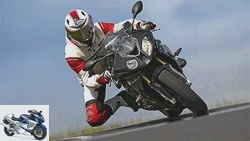
Super athlete
Endurance test interim result: BMW S 1000 RR
Endurance test of the BMW super sports car
read more
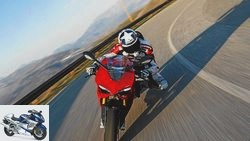
Super athlete
Top test Ducati 1199 Panigale
The strongest production two-cylinder in the test
read more
PS data and measured values
Jahn
The air is getting tight for the BMW S 1000 RR. During this test, she had to use all her tricks to keep the Ducati 1199 Panigale S at a distance.
BMW S 1000 RR
Drive:
Four-cylinder in-line engine, four valves / cylinder, 142 kW (193 hp) at 13000 / min *, 112 Nm at 9750 / min *, 999 cm³, bore / stroke: 80.0 / 49.7 mm, compression ratio: 13.0 : 1, ignition / injection system, 48 mm throttle valve, mechanically operated multi-disc oil bath anti-hopping clutch, six-speed gearbox, G-Kat, chain, traction control
Landing gear:
Light alloy bridge frame, steering head angle: 66.0 degrees, caster: 99 mm, wheelbase: 1423 mm, upside-down fork, Ø fork inner tube: 46 mm, adjustable in spring base, rebound and compression. Central spring strut with deflection, adjustable in spring base, rebound and compression (high / low). Suspension travel front / rear: 120/130 mm
Wheels and brakes:
Light alloy cast wheels, 3.50 x 17 / 6.00 x 17, front tires: 120/70 ZR 17, rear: 190/55 ZR 17, test tires: Pirelli Diablo Supercorsa SC2, 320 mm double disc brakes with four-piston fixed calipers at the front, 220 mm -Single disc with single-piston floating caliper at the rear, ABS
Measurements and weight:
Length / width / height: 2020/800/1090 mm, seat / handlebar height: 805/855 mm, handlebar width: 640 mm, 208.5 kg fully fueled, v./h .: 51.5 / 48.5%
Rear wheel power in last gear
137 kW (186 PS) at 273 km / h
Consumption:
Fuel type: Super unleaded. Average test consumption: 13.7 liters / 100 km, tank capacity 17.5 liters, range: 128 km
Base price:
16,100 euros (plus additional costs, ABS + DTC 1230 euros, automatic switch 364 euros, heated grips 197 euros, recording 590 euros)
Ducati 1199 Panigale S.
Drive:
Two-cylinder 90-degree V-engine, four valves / cylinder, 143 kW (195 PS) at 10750 / min *, 132 Nm at 9000 / min *, 1198 cm³, bore / stroke: 112.0 / 60.8 mm , Compression ratio: 12.5: 1, ignition / injection system, 67.5 mm throttle valves, hydraulically operated multi-disc oil bath anti-hopping clutch, six-speed gearbox, G-Kat, chain, traction control
Landing gear:
Load-bearing motor with light metal subframe, steering head angle: 65.5 degrees, caster: 100 mm, wheelbase: 1437 mm, upside-down fork, Ø fork inner tube: 43 mm, adjustable spring base, rebound and compression stage. Central spring strut with deflection, adjustable in spring base, rebound and compression. Suspension travel front / rear: 120/130 mm
Wheels and brakes:
Forged alloy wheels, 3.50 x 17 / 6.00 x 17, front tires: 120/70 ZR 17, rear: 200/55 ZR 17, test tires: Pirelli Diablo Supercorsa SC2, 330 mm double disc brakes with radially attached four-piston fixed calipers at the front, 245 -mm single disc with two-piston fixed caliper at the rear, ABS
Measurements and weight:
Length / width / height: 2060/810/1110 mm, seat / handlebar height: 820/850 mm, handlebar width: 670 mm, 195 kg fully fueled, v./h .: 52.5 / 47.5%
Rear wheel power in last gear:
131 kW (178 PS) at 279 km / h
Consumption:
Fuel type: Super unleaded. Average test consumption: 12.9 liters / 100 km, tank capacity 17 liters, range: 132 km
Base price:
24,490 euros (plus additional costs and 440 euros DDAplus)
archive
Measured values from the BMW S 1000 R and the Ducati 1199 Panigale S..
Let’s not kid ourselves: Without regulatory electronics, BMW and Ducati would be extremely difficult to drive with their brutal power. The Ducati already sprawls at 4000 revs with 100 Newton meters on the crankshaft, the BMW as a four-cylinder sets this mark at 6500 revs. On the race where this test took place, speeds below 5000 rpm are irrelevant, so that none of the rivals can really stand out in the acceleration duel above 6000 rpm. More than bare force, electronics now decide whether to overtake or be overtaken. The more sensitive and revealing the traction control works, the faster the bike gets.
Performance
| Acceleration** | Top speed * | |||||
| 0-100 km / h | 0-150 km / h | 0-200 km / h | 50-100 km / h | 100-150 km / h | ||
| BMW S 1000 RR | 3.2 s | 5.1 s | 7.1 s | 4.3 s | 4.0 s | 299 km / h |
| Ducati 1199 Panigale S. | 3.2 s | 4.9 s | 7.6 s | 4.9 s | 4.9 s | 296 km / h |
* Manufacturer information ** PS measurement
Test tire
Jahn
In the test we used the Pirelli Diablo Supercorsa in the medium mixture SC2 .
No serious racetrack test can do without uniform test tires. In this case we used the Pirelli Diablo Supercorsa tread tire in the medium compound SC2, which is very popular with amateur racers, in order to ensure the optimal functioning of the Ducati traction control. The Italo skins pampered us in the great heat prevailing during the test (air up to 38 degrees, asphalt up to 55 degrees) not only with the best grip and soft threshold area, but they also withstood the attacks of the over 190 hp engines for a long time . Amazingly, the Ducati’s rear tires looked a little better than those of the BMW after both days of testing. During the test, we used the recommended air pressure of (measured hot) 2.3 bar at the front and 2.0 bar at the rear.
Recording systems in use
Jahn
Thanks to recording systems, a quick look at the laptop can reveal the strengths and weaknesses of the rider and motorcycle.
BMW and Ducati offer recording systems for lap analysis for their superbikes. PS takes a close look at the systems and shows their benefits for hobby racers.
The memory stick as a data storage device sits under the hump cover on the Duc if you want to drive fast, you have to know what you’re doing. If you want to drive even faster, you have to know where you can do more. To do this, he needs unadulterated information that modern recording systems can provide. Both BMW and Ducati offer their Superbike customers recording systems in their in-house accessories catalog. Reason for PS to take a closer look at these systems and examine them for the benefit for the pilot.
Attachment: PS received both test machines with attached systems, which is why we cannot say anything about the attachment and effort. However, we recommend pilots with little electronic experience to have the logger retrofitted by a specialist.
Preparation: The application of the systems on site is fundamentally different from one another. With BMW, it is sufficient to place the external infrared transmitter on the pit wall and point the infrared receiver on the motorcycle in the direction of the transmitter. After these steps, each lap is recorded by GPS. After the turn, the collected data is transferred from the motorcycle to the computer using a memory stick. At Ducati, the activation of the recording is much more complex. Every time the motorcycle ignition was off, the DDAplus system must be reactivated via the instrument cluster. If this is finally done, a point on the route must be “marked” within the first laps using the flasher button, which is then defined as a “trigger point” for the session. A recording of the out-lap is therefore not possible, since, for example, a trigger point set in the pit lane on the start-finish straight that is driven later is not recorded by the GPS system.
archive
DRS from Ducati: The driven route (here Most / CZ) can be viewed in real surroundings via Google Earth. It’s nice, but useless.
Use: The be-all and end-all of recording systems are the depth of information, i.e. the number and relevance of the information recorded, and the evaluation options. The applications of BMW and Ducati differ considerably here. In other words, the DDAplus from Ducati is nothing more than a lap timer that has been upgraded with just a little additional information. Nine channels, i.e. nine different pieces of information, are available to the pilot for viewing and evaluation, whereby the altitude profile and the total distance traveled can certainly be classified as unimportant. The display of the gear steps, the gas position and the representation of the TC interventions are more interesting. Using the gear indicator, the appropriate secondary ratio for a route can be worked out more quickly, and the TC control protocol can be used to check the subjective impression of the pilot and set the TC to suit the driving style. But that’s about it.
archive
The BMW / 2D system is a professional tool and represents 26 “channels”. Each channel provides information that needs to be interpreted.
The BMW system works significantly better because it is really professional. The system purchased from recording expert 2D and applied for the S 1000 RR differs only in a few points from the systems used in MotoGP, World Superbike or IDM. It offers 26 useful information channels that can also be professionally evaluated. For example, the comparison between the throttle position, the “driver’s request on the throttle” and the actual throttle valve opening angle “Throttle” is very interesting. Only by recording these two channels is it possible to see how much the pilot is actually being “patronized” by the control electronics.
archive
Just an average of many: the black line between the measuring points shows the average delay end start – finish.
However, it is much more important to consider a selected braking point to improve lap times. If you mark the corresponding section of the route, you can see on the one hand whether you a) brake too early or too late, b) what brake pressure is applied and c) what average deceleration is achieved. This information can be implemented one-to-one in the next turn by concentrating precisely on this curve, for example braking a little later and harder. On the other hand, you can also check your own fitness and check lap by lap whether the braking point was always at the same point or whether you slacked off over the distance of the training and thus braked earlier.
Conclusion: What both systems have in common is the lack of a proper and detailed operating manual. In addition, both systems confirm that data acquisition is good and important, but only ever worth as much as the evaluation options and the associated analysis. While the € 440 DDAplus from Ducati definitely offers far too little – especially analysis options – the BMW system, which costs € 600, provides a sensible selection of data that can overwhelm a layperson. However, everyone can familiarize themselves with the BMW system and then have a real professional tool at the start.
Price comparison for Ducati Panigale 1199 S and BMW S 1000 RR
1000PS marketplace app
Used Panigale 1199S and S1000RR in Germany
Both super athletes are real dream bikes. They make the hearts of speed junkies and amateur racing drivers beat faster. If you want to really let it rip on your favorite track with the Panigale 1199S or the S1000RR, it is worth taking a look at the used market. On the used motorcycle exchange you can find new bikes from Ducati and BMW: Used Ducati Panigale 1199 S and BMW S 1000 RR super sports bikes in Germany
Related articles
-
Ducati 1299 Panigale S and Ducati 1199 S in comparison test
fact 29 pictures fact 1/29 The two sisters only look like identical twins at first glance … fact 2/29 wheelbase (1437 mm), seat height (830 mm) …
-
Ducati 1199 Panigale S – The new super sports car
Ducati driving report: Ducati 1199 Panigale S The new super sports car from Ducati Your task is clearly defined: be fast on the racetrack. For…
-
Ducati 1199 Panigale in the 50,000 km endurance test
38 pictures 1/38 Summer, sun, milling curves, the Panigale is in its element. Lohse 2/38 “Can I finally …
-
Test: BMW S 1000 RR against HP4 and Ducati 1199 Panigale against Panigale S.
30 pictures 1/30 The top super sports cars from BMW (HP4 and S 1000 RR) and Ducati (1199 Panigale / S) in the large …
-
Comparison test BMW S 1000 RR, Ducati 1299 Panigale S and Yamaha YZF-R1
fact 46 pictures fact 1/46 Yamaha YZF-R1. fact 2/46 BMW S 1000 RR. fact 3/46 The swing arm takes the wheel axle very far back – good for the …
-
Comparison test: super sports cars under 1000 cubic meters from MV Agusta, Ducati and Kawasaki
Jahn 46 pictures Jahn 1/46 Kawasaki ZX-6R 636 Jahn 2/46 But the Evo is not alone in this. All three bikes rock the ring during the test. Jahn 3/46 ……
-
Comparison test Aprilia RSV4 R APRC and Ducati 1199 Panigale
fact comparison test: Aprilia RSV4 R APRC and Ducati 1199 Panigale The best Italian superbikes in comparison The more expensive versions first – few …
-
BMW, Ducati, Suzuki and Triumph super sports cars in a comparison test
29 pictures 1/29 Triumph Daytona 675, Ducati 848 Evo Corse SE, BMW S 1000 RR, Suzuki GSX-R 750. Different bikes – different …
-
Ducati 999 S and Ducati 1199 Panigale S in comparison test
fact 14 pictures fact 1/14 The rattling through town with the Ducati 999 S is deep in the memory. But honestly, there is the current Ducati …
-
Generation comparison Ducati 1299 Panigale R Final Edition 2017 and Ducati 1199 Panigale from 2012
markus-jahn.de 27 pictures markus-jahn.de 1/27 Generation comparison: 1199 Panigale vs. 1299 Panigale R Final Edition. markus-jahn.de 2/27 …